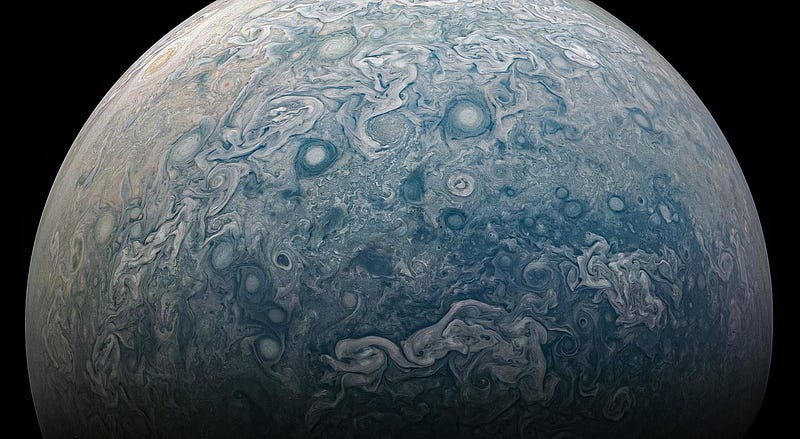Exciting Countdown to JUICE Mission Launch for Jupiter Exploration
Written on
The Countdown Begins for the JUICE Mission
The anticipation builds as we approach the launch of the JUICE mission. The European Space Agency’s six-ton probe, JUICE, is currently positioned in Toulouse, awaiting its journey to French Guiana. Once there, it will be fitted into the payload bay of an Ariane 5 rocket, scheduled to lift off towards the Jupiter system in mid-April. This marks ESA's inaugural large-scale mission.

[Photo: NASA/JPL-Caltech/SwRI/MSSS, Public domain, via Wikimedia Commons]
The launch of JUICE, which stands for JUpiter ICy Moon Explorer, is anticipated as one of the most significant space events of the first half of 2023. Initially slated for last year, delays caused by the pandemic extended the integration of JUICE’s components. Thankfully, a new launch opportunity arises in April. If the launch proceeds as planned, the probe will embark on an 8.5-year journey covering a distance of 6.6 billion kilometers to reach the Jupiter system.
Understanding the Jupiter System
Why focus on the Jupiter system instead of just Jupiter and its moons? Jupiter and its satellites create a unique planetary system within our solar system. This mission is poised to enhance our comprehension of the universe. There are compelling theories suggesting that Jupiter could have been a star, but its formation was halted. By studying its structure and the gravitational dynamics with its moons, we can gain insights into the formation of our Solar System and potentially others.
JUICE is the largest spacecraft ever constructed for interplanetary exploration, equipped with ten scientific instruments developed by diverse international teams. One such instrument, the Radio Plasma Wave Investigation (RPWI), will measure plasma characteristics and its interactions within the space environment. The Space Research Center of the Polish Academy of Sciences was pivotal in developing the mechanical systems during the initial mission phase, which were later handed to Astronika for detailed design and testing.
The data gathered by the RPWI will shed light on how Jupiter's intense electric and magnetic fields interact with its largest moons, Ganymede and Europa. Another instrument in development, the Submillimeter Wave Instrument (SWI), aims to observe submillimeter waves produced by excited molecules in Jupiter's atmosphere.
Exploring Life Near Jupiter
The intrigue surrounding the Jupiter system extends beyond understanding planetary systems—it encompasses the tantalizing possibility of extraterrestrial life. Europa, one of Jupiter’s moons, presents a strong case for harboring life, primarily due to the potential presence of a liquid ocean beneath its icy crust. Observations have suggested that Europa’s surface is highly geologically active, likely fueled by the immense gravitational forces exerted by Jupiter. This energy could create conditions suitable for life, even at such vast distances from the Sun.
Four Years of Exploration
Airbus is the main designer behind the JUICE probe, where the integration of its ten research instruments took place. Remarkably, the largest solar panels ever fitted to a probe, spanning an area of 85 square meters, were assembled here as well.
The probe is set to explore the Jupiter system for nearly four years, conducting 30 flybys of its moons, including nine dedicated overflights of Ganymede. To achieve this, JUICE must first navigate a lengthy journey and perform four gravity assist maneuvers to reach the necessary speed.
JUICE will collaborate with NASA’s Juno probe, and the upcoming Europa Clipper mission will also contribute to this exploration. Together, these missions aim to provide complementary and precise data back to Earth. Notably, both JUICE and Juno have roots in the previously proposed Europa Jupiter System Mission—Laplace, which was intended as a joint effort between NASA and ESA.
A Unique Discovery on Mars
In a fascinating turn of events, NASA’s probe recently captured a remarkable image of Mars, depicting what appears to be a bear-like formation.
Thank you for reaching the end of this article! Your support through claps, follows, or tips would be greatly appreciated. Thank you!